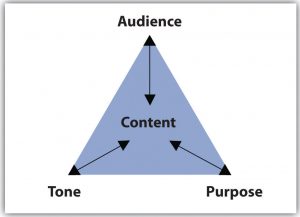8.4 Tone
When we speak of tone in writing, we’re referring to author’s attitude toward the reader and the subject of the message. Just as your tone of voice can affect how messages are received, writing tone affects readers in the same way.
Why Should Tone and Voice be Considered?

Writers should consider the audience and purpose of each assignment and be mindful of the tone and voice they use to communicate with their readers. Sensitivity to the audience’s stance or point of view on a particular topic will affect their perception of the writer as the argument or analysis unfolds; a respectful tone is more likely to reach the audience than one that is condescending.
When the goal is to persuade an audience with an opposing view, writers must think carefully and empathically about how their tone and voice will affect their readers.
Guidelines for Ensuring an Appropriate Tone
- Be Confident – You can feel confident if you have carefully prepared and are knowledgeable about the material you wish to express. The manner in which you write should assume a confident tone as well. Consequently, a confident tone will have a persuasive effect on your audience, making readers more inclined to accept your position. Employers are inclined to hire individuals who appear confident and sure of their abilities. This does not mean, though, that you should appear overconfident, as this can easily be interpreted as arrogance.
EXAMPLE:
Not: You must agree that I am more than qualified for the position.
But: My qualifications in accounting and customer service exceed your job requirements.
- Be Courteous and Sincere – A writer builds goodwill for him or herself by using a tone that is polite and sincere. It is important to strive for sincerity in tone; without it, politeness can sound condescending. Consider the words and phrases you use in your document and how your reader will likely receive them. If you are respectful and honest, readers will be more willing to accept your message, even if it is negative.
EXAMPLE:
Not: You didn’t read the instructions carefully, thus your system has shut down.
But: The system may automatically shut down if any installation errors occur.
Figure 8.4.2 shows the relationship between audience, purpose, content, and tone:

Just as speakers transmit emotion through voice, writers can transmit through writing a range of attitudes, from excited and humorous to somber and critical. These emotions create connections among the audience, the author, and the subject, ultimately building a relationship between the audience and the text. To stimulate these connections, writers intimate their attitudes and feelings with useful devices, such as sentence structure, word choice, punctuation, and formal or informal language. Keep in mind that the writer’s attitude should always appropriately match the audience and the purpose.
Assessing Tone
To assess tone, take time to consider the purpose of your document. When you consider the message and how you wish to express it, the tone should become apparent.
Consider these questions related to tone and voice:
-
-
- What is the writing’s stance? Is the intent to inform or to persuade?
- What tone and voice is most appropriate for the target audience?
- Are the tone and voice respectful?
- How can the content be presented so it is informative and persuasive but not condescending?
- What words demonstrate sensitivity to the audience’s views and feelings?
- Have any insensitive words or examples been presented that could cause offense to the readers?
-
Additional Resources
- “Tone in Business Writing,” a guide from the Purdue OWL
*This page borrows from the following sources: "How Will Your Reader Respond to This Tone?" Technical Writing. Source link. "Purpose, Audience, Tone, and Content." Successful Writing. Source link. Figure 8.4.1: Piacquadio, Andrea. Pexels.com. Figure 8.4.2: Successful Writing.

